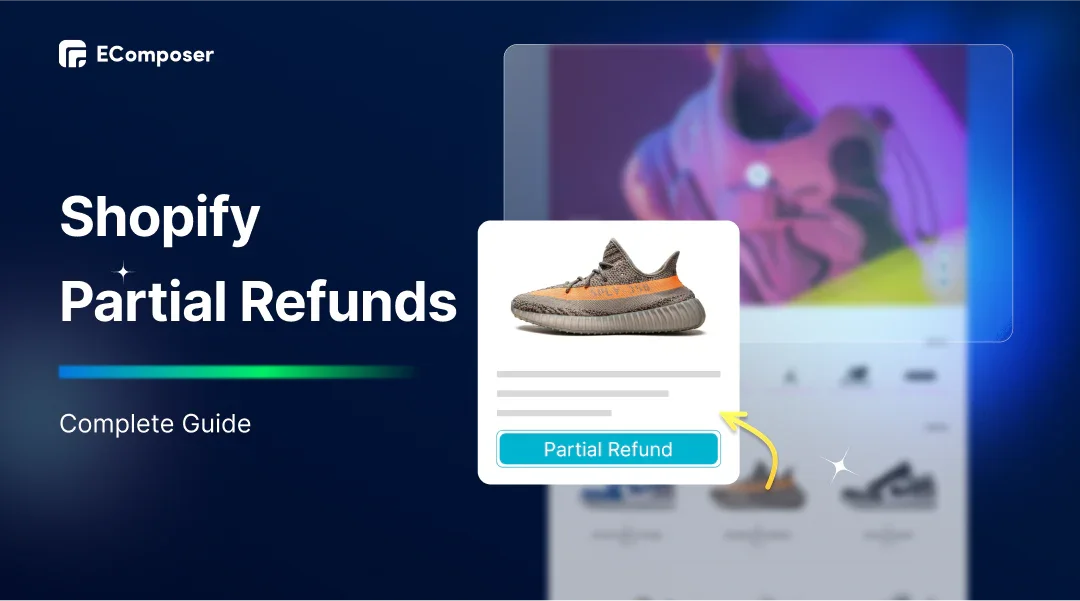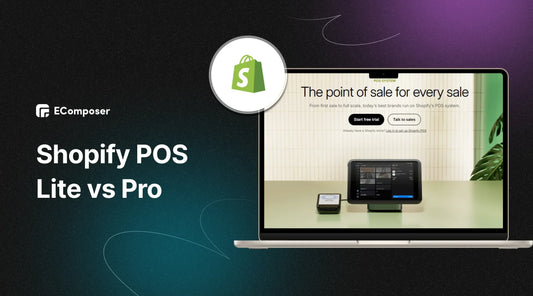Complete Guide to Shopify Partial Refunds in 2025

Table Of Contents
In 2025, Shopify's partial refunds option will be crucial for online retailers since it gives them flexibility in handling consumer complaints. These refunds improve the overall purchasing experience by enabling vendors to return a portion of the purchase price without having to cancel the entire transaction.
In order to increase customer happiness and retention in 2025, it will be essential to grasp Shopify partial refunds. Businesses may manage product faults more skillfully, lower returns, and preserve good customer relations while maintaining constant income by providing partial refunds.
What is a Shopify Partial Refund?

A Shopify partial refund allows merchants to refund a portion of the order amount without canceling the entire purchase. Unlike a full refund, where the customer is reimbursed the total amount, a partial refund only covers specific items or a percentage of the order. When clients wish to keep certain things from their order but have problems with others, this is the best course of action.
Everyday use cases for partial refunds include damaged products, shipping delays, or pricing adjustments. The adaptable approach aids in resolving consumer issues without compromising the integrity of the remaining transaction.
Why Partial Refunds Matter for Your Shopify Store

Because partial refunds provide a flexible solution to order difficulties, they are essential in improving customer happiness. When customers receive a partial refund for damaged, missing, or unsatisfactory items, it shows that the store values their concerns and is willing to resolve them without canceling the entire order. Recurring revenue and consumer loyalty are increased by this tactic, which also helps to build better client connections and trust.
Partial refunds assist safeguard earnings from a revenue standpoint by obviating the requirement for complete refunds. Instead of losing the entire sale, stores can retain most of the revenue while offering compensation for specific issues. In order to maintain profitability while still addressing customer concerns, this creates a balance between revenue retention and customer care.
How to Issue a Partial Refund on Shopify
Issuing a partial refund on Shopify is a straightforward process that allows you to resolve customer issues without refunding the full order amount. Here's a detailed guide to help you handle partial refunds efficiently:
Step 1: Log in to Shopify admin
First, sign in to your Shopify admin account. This will take you to the dashboard, where you can manage all aspects of your store, including orders and refunds.

Step 2: Go to Orders
Navigate to the "Orders" section, which you'll find in the left-hand menu. This section lists all customer orders, where you can search and select the specific order you want to refund.
Step 3: Click the order that you want to refund
From the list of orders, click on the order in question. You'll be taken to a detailed view showing all the products purchased, payment information, and the customer's details.

Step 4: Click Refund
At the bottom of the order details page, click the "Refund" button. This will open up options for issuing either a full or partial refund.

Step 5: Setting the Options
Here's where you can specify which items to refund. Set the quantity for each item you're refunding, and leave any items that aren't part of the refund at a quantity of zero. You can also adjust shipping fees, import taxes, and restocking options depending on the situation. If the customer uses a gift card or another payment method, Shopify will automatically prioritize refunding the gift card first.

Step 6: Click Save
Once you've finalized the refund details, click "Save" to process the partial refund. Your order's status will update to "Partially refunded," and your customer will be notified if you opt to send them a refund notification.

You may handle partial refunds efficiently by following these procedures, which will provide you flexibility in addressing problems and preserving good client relations.
How to Restock an Order
Restocking items in Shopify is a quick and straightforward process, especially when there's no need for a refund or return. By restocking products that were part of an order that was canceled or partially reimbursed, it makes inventory management easier.
Here's how to restock an order step-by-step:
Step 1: Select Orders
First, head to your Shopify admin dashboard and navigate to the "Orders" section on the left-hand side of the screen.
Step 2: Click the order that you want to restock
Find and click on the specific order where you want to restock items. This will take you to the order details page, which shows all the products, quantities, and customer information.

Step 3: Click Edit
On the order details page, locate the "Edit" button. Clicking this will allow you to adjust the stock levels for the products in the order.

Step 4: Select Remove item
Next, in the Add product section, select the blue words “Remove item”.

Step 5: Update order
Finally, hit the "Update order" button to update your inventory. Once completed, your stock levels will be updated to reflect the returned items.

Best Practices for Managing Partial Refunds

Managing partial refunds effectively is vital to maintaining customer satisfaction and keeping your Shopify store's finances in balance. Here are some best practices for handling partial refunds:
Communicate Clearly with Customers
Transparency is essential when issuing a partial refund. Before processing the refund, ensure the customer understands why they're receiving a partial amount instead of a full refund. Give concise justifications for any deductions made, such as shipping charges or non-returnable merchandise.
Use Refunds Strategically
Partial refunds can be a powerful tool for resolving customer issues without losing the entire sale. Offer partial refunds for minor product defects, delayed shipments, or service issues to keep customers happy and avoid full returns. This approach not only satisfies the customer but also retains revenue for your store.
Track Refunds and Inventory Closely
When processing a partial refund, remember to update your inventory levels if applicable. Use Shopify's restocking feature to ensure your stock is accurate and that refunded items are available for future sales. Keeping a close eye on refunds and inventory will help you avoid overselling products.
Set Clear Return and Refund Policies
Having well-defined refund policies is critical. Make sure your return policy outlines when partial refunds are allowed and under what conditions. This reduces confusion for both your team and your customers, streamlining the refund process.
Monitor Customer Feedback
After issuing a partial refund, following up with customers to make sure their issue has been successfully fixed is a smart practice. Collecting feedback helps you improve your processes and maintain strong relationships with your customers, increasing the likelihood of repeat business.
Common Challenges with Shopify Partial Refunds

Although Shopify's partial refund option is an effective tool, businesses should be mindful of the unique set of difficulties associated with it. Here are some common issues businesses might encounter when processing partial refunds:
Gift Card and Payment Method Confusion
One challenge is managing refunds when customers have used multiple payment methods, such as a gift card combined with a credit card. Shopify prioritizes refunding the gift card first, which can confuse both the merchant and the customer if not appropriately handled. Merchants must be careful to adjust refund amounts accurately for each payment method.
Inventory Management
When issuing partial refunds, it's crucial to ensure that inventory is properly restocked. Failing to update stock levels can lead to inaccurate product availability, overselling, or inventory shortages. Shopify allows for manual restocking, but errors can occur if this step is overlooked.
Customer Misunderstandings
Customers may only sometimes understand why they are receiving a partial refund instead of a full one. With clear communication, this can lead to satisfaction or complaints. Providing upfront explanations of what's being refunded and why is essential to avoid confusion and maintain trust.
Shipping and Additional Fees
Handling refunds for shipping costs or taxes can be tricky. Depending on the order, merchants might need to decide whether or not to include shipping in the partial refund. Additionally, dealing with duties, import taxes, or additional fees requires careful attention to avoid over- or under-refunding.
Tracking Refund History
Managing multiple partial refunds on a single order can become complicated, especially when you need to track the refund history. Ensuring that refunds are accurately documented and associated with the correct transactions is critical to maintaining clean financial records and avoiding discrepancies.
FAQs
Are there any fees associated with issuing partial refunds on Shopify?
No, Shopify doesn't impose extra costs for providing partial refunds. However, standard transaction fees from payment gateways like PayPal or credit card processors may still apply depending on the specific terms of your payment provider. To be aware of any expenses that may arise while processing refunds, it is imperative that you study such agreements.
What are the best practices for managing partial refunds?
For partial refunds to be managed successfully, there must be clear customer communication. Always explain why a partial refund is being issued and which items or charges are being refunded. When replenishing returned goods, it's also critical to keep an eye on and update inventories on a frequent basis. To prevent misunderstandings and expedite the procedure, a precise refund policy should be created that details the circumstances in which partial returns are permitted.
Can I customize my refund policy for partial refunds?
Yes, Shopify allows you to customize your refund policy fully. For partial reimbursements, you can specify certain restrictions like eligibility requirements, time limits, and stipulations. Make sure that your website has a visible display of this policy so that clients are aware of the conditions before making a purchase. Conflicts are decreased and consumer expectations are managed with the aid of a clear, personalized policy.
How do I automate the partial refund process on Shopify?
To automate the partial refund process, you can integrate third-party apps or use Shopify Flow (available on Shopify Plus) to create automation rules. With the use of these tools, you may set up specified circumstances, such broken goods or client comments, to automatically initiate partial refunds. Time is saved and reliable refund processing is guaranteed when this procedure is automated.
Are there any legal requirements for issuing partial refunds?
Legal requirements for issuing partial refunds vary by region, so it's essential to stay compliant with local consumer protection laws. Some countries may require you to offer refunds for defective products or delayed deliveries. Always check the regulations in the markets where you operate to ensure your refund practices align with legal obligations.
Read more:
- Shopify Partial Payments: A Comprehensive Guide
- How to Cancel an Order on Shopify
- Handling Shopify Chargebacks: Solutions And Prevents
- How To Accept Shopify Split Payments?
- How to See Shopify Payouts
Conclusion
In conclusion, mastering partial refunds on Shopify is a key strategy for maintaining customer satisfaction and efficient business operations in 2025. By offering flexible solutions to customer issues without needing to refund entire orders, you can protect your revenue while keeping customers happy. The process of issuing partial refunds is straightforward, and with the proper management practices, it becomes a powerful tool for resolving complaints and building trust.
As customer expectations continue to evolve, implementing partial refund strategies will be essential for creating positive shopping experiences. By staying transparent, customizing your refund policies, and automating where possible, you can enhance your store's reputation and encourage repeat business throughout the year.






















0 comments